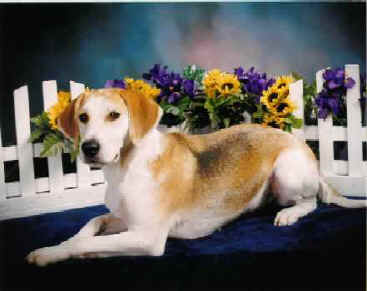Find Out about
the Savvy Harrier
Breed of Dog
|
|
Help Homeless Pets with a One Dollar Donation
Discover how to Keep a Harrier in the Best of
Condition
By: The Tipster, plus her good buddy, Alfred
The Harrier breed of dog is a cheerful, outgoing, playful, sweet-
tempered, tolerant dog that does very well with children.
This dog is a pack dog and gets along fine with other dogs,
but around non-canine pets they should be supervised. It
prefers to be around its pack mates, whether they are people
or canines.
The Harrier is an active dog that will explore, sniff around
and trail. When outdoors, be sure to keep this dog on a
leash or in a safely confined area. Some Harriers do like to
bay so be prepared to train your dog about this. Harriers
make wonderful watchdogs as they are determined and
watchful.
They do require firm, patient training. It is important that
you maintain leadership status with this dog. They also need
regular physical and mental exercise including a long daily
walk in order to prevent separation anxiety.
Harriers are hunting hounds that have an excellent nose,
superior stamina in the field and that are swift runners.
The actual origins of this breed are unknown and there are
many conflicting stories about it. According to some breed
historians, earlier Harrier type dogs were crossed with the
Bloodhound, the Talbot Hound, and the Basset Hound. If so,
that would explain the Harrier's great nose and drive to
hunt.
Another explanation of the breed's origins asserts that the
Harrier was developed from crossing the English Foxhound,
the Fox Terrier and the Greyhound. A third source states
that the Harrier is a bred-down version of the English
Foxhound. No matter which explanation is the case, today's
Harrier is somewhere between the Beagle and the English
Foxhound in size and is primarily used to hunt hares, though
the breed is also good at fox hunting. The Harrier is named
for its specialty of hunting hares.
Neither fox nor hare can escape this dog's exceptional sense
of smell, boldness and cunning. They have been known to
chase their prey until it literally collapsed from
exhaustion. In the United States the Harrier is still a
relatively rare breed but has a long history in England as a
working pack dog and is still popular today there.
The Harrier has a similar build to the English Foxhound,
just smaller. It is a compact dog that is hardy and speedy
with the best sense of smell. A hunting dogs that is very
muscular. The Harrier is built with large bones for added
stamina and strength. The dog is slightly longer than it is
tall with a level top line. The tail is carried high,
doesn't curl over the back and is medium length.
The skull is broad with a square, strong muzzle. The ears
are pendant and rounded. The eyes are brown or hazel in
color with a mellow expression and an alert and relaxed look
when excited. The nose is wide and black. The teeth should
come together in a level or scissors bite. The dog has a
hard short coat that comes in colors of lemon and white, red
and white and white and tan but there really are no limits
on color. The back is all black sometimes.
Harrier

Feeding the Harrier Breed of Dog
By: Jane Bicks, D.V.M.
The Harrier breed looks much like a smaller edition of the
American Foxhound.
The Harrier is a very energetic breed. It needs plenty of exercise
Calorie counting and exercise are a must for the
older dog, because an overweight Harrier just
isn't socially acceptable.
Our Choice for a Savory Dog Food and Treat for Harrier Dogs
Size: Medium
Weight: 48-60 lbs.
Height: 19-22 inches
Coat: Short, coarse and hard.
Color: Any hound color including blues.
Scrumptious Treats for the Harrier

Learn about each of the Dog Breeds
Uplifting Gifts for Harriers and all Breeds
|